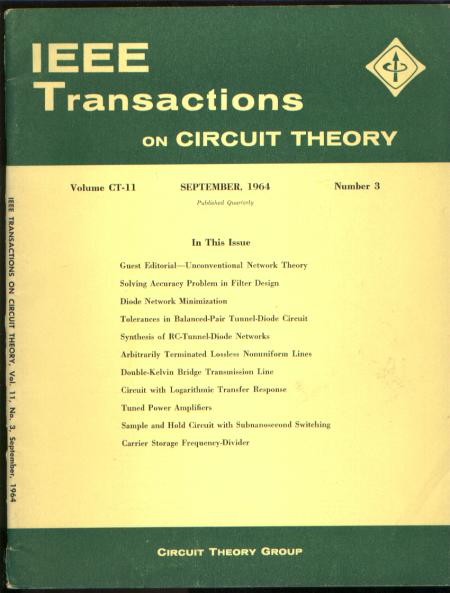
IEEE Transactions on circuit theory September 1964 vol CT-11 no 3.
Circuit Theory Group IEEE, 1964, pp 324-439 inclusive; photos, illus, refs.
Condition: Good overall, journal, magazine format 8.5x11, yellow and green covers; some shelfwear; some thumbwear and edgewear, cover colors scuffed & rubbed; stapled binding, covers beginning to loosen from staples; pages clean; bit of musty smell from long storage.
Keywords: network theory, circuit theory
Categories: Electronic and Electrical Engineering
See all items by IEEE Transactions on circuit theory September 1964 vol CT-11 no 3
Price: $12.50
Item Description
IEEE Transactions on circuit theory September 1964 vol CT-11 no 3. Includes -- Guest editorial, Herbert Carlin, on Unconventional Network Theory; Solving accuracy problem in filter design; Diode Network minimization; Tolerances in balanced-pair tunnel- diode circuit; synthesis of RC-tunnel diode networks; Arbitrarily terminated lossless nonuniform lines; double-kelvin bridge transmission line;Circuit with logarithmic transfer response; tuned power amplifiers; Sample and hold circuit with subnanosecond switching; Carrier storage frequency divider; more - incl. correspondence, book reviews, photographs etc. '
The Classic Age of network theory has ended. This period stretches from about 1924, the date of publication of Foster's Reactance Theorem to perhaps 1954, the date of publication of the complete synthesis of reciprocal and nonreciprocal lumped passive n ports in terms of the scattering matrix by Belevitch, and Oono, and Yasuura. We also have had a preclassic or medieval period in which Kirchhoff, Campbell, Heaviside and Pupin figured as key contributors, the latter two in the domain of transmission line circuits.
Included within the three decades of the age of classicism are the contributions that have made the names of Caron, Cauer, Bayard, Guillemin, Bott-Duffin and Tellegen into household words (that is, in the households of network theorists). These men and others of the same generation have been primarily concerned with the theory of positive element RLC networks, important in the engineering design of electronic circuits. However in the last decade 1954 to 1964 there are signs that another era may be upon us, a network approach to problems outside the now conventional domain of lumped passive circuits that will play a significant role in the newly developing technologies that surround us...' (Carlin in his essay on Unconventional Network Theory).
